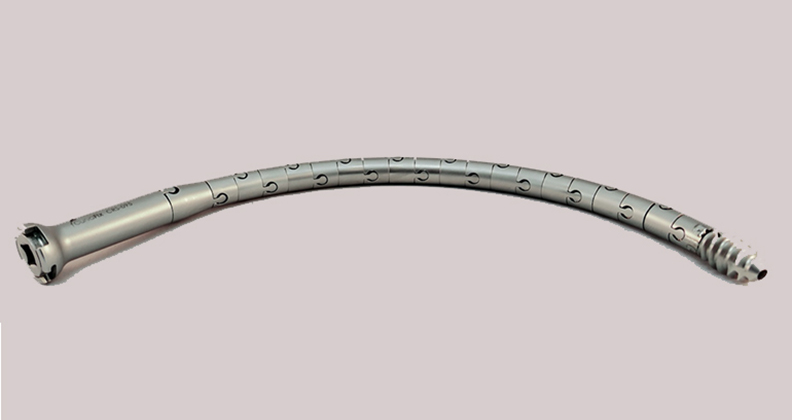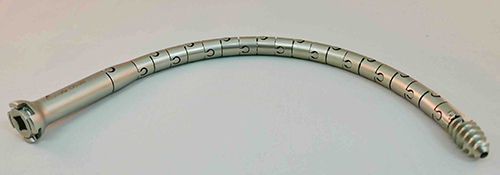
While orthopedic companies are invested in delivering effective devices to better suit the patients they serve, the new technology doesn’t always result in innovation shifts. Old habits tend to die hard, whether it’s an orthopedic surgeon opting for the familiarity of a specific implant, or a device company making slight adjustments to a pre-existing product to achieve quick FDA clearance and commercialization. However, a burgeoning cast of small orthopedic implant companies is bucking this trend by developing devices designed to anticipate and suit individual patients’ unique anatomy.
“The trend we see and that we’re following along with is for implants that are optimized for different types of fractures and that are better adapted to the patient’s anatomy,” said Steve Dimmer, President and CEO of the Washington-based orthopedic device company CurvaFix.


CurvaFix Intramedullary Rodscrew
Pelvic Fractures
The CurvaFix Intramedullary Rodscrew is the company’s flagship device. Described by Dimmer as an “intramedullary bone fixation device,” the Rodscrew is designed for patients with pelvic fractures, a notoriously difficult injury for orthopedic surgeons to address due to the curvature of the bone.
“We chose to start with the pelvis because it’s one of the more technically challenging fractures that orthopedic surgeons have to deal with. We set out to develop a minimally invasive device that follows the bone curvature and fills the intramedullary space,” Dimmer said.
Inside the stainless steel device are four cables that are fixed at one end and are loose on the end that faces the surgeon. The device is flexible when it’s implanted through a small incision, and becomes firm when an internal suspension bridge is activated by a locking mechanism that holds the device’s shape in place.
“There really hasn’t been a lot of innovative stuff going on in pelvic fractures,” said Dimmer, who explained that conventional plate and screw implants have been the typical go-to implants for orthopedic surgeons until now.
To design the Rodscrew, CurvaFix felt that it needed a broader understanding of pelvic anatomy, so it conducted its own morphology study involving 100 patients. The study results helped CurvaFix design the only pelvic implant device on the market that can adapt to a patient’s anatomy and become rigid, Dimmer said. CurvaFix’s Rodscrew received FDA 510(k) clearance in 2019, and the company is currently engaged in a postmarket study with plans to bring the product to U.S. markets upon completion.


MedShape DynaNail
Foot and Ankle Fractures
Kurt Jacobus, Ph.D., President and CEO of the Atlanta-based orthopedic company MedShape, shares CurvaFix’s philosophy of using innovation to bring attention to a traditionally passed-over area of orthopedics.
“We believe very strongly that the foot and ankle market is in the early days of a transition from static ‘me too’ plates, screws and nails––things that have been around since shortly after the Civil War–– to dynamic staples, screws and nails that apply continuous compression, adjust to changing anatomy during healing and lead to better outcomes,” Dr. Jacobus said.
Founded by a foot and ankle surgeon and university professor in 2005, MedShape’s suite of products leverage nickel titanium (NiTiNOL) and polymer materials to design foot and ankle implants for patients with unsuccessful fracture fixations and joint non-unions.
“Nickel titanium is a metal alloy just like titanium that’s used regularly in the human body,” Dr. Jacobus said, “but the difference is that nickel titanium can elongate up to 20 times the amount that titanium can and fully recover. It can look and behave like a very strong rubber band, if you will.”
According to Dr. Jacobus, stretching and applying the material to an intended site for fusion can sustain compression in the face of bone settling and remodeling to promote fusion, compared to static devices that would hold the intended fusion sites apart.
MedShape’s sizable ambitions have been recognized and supported by some of America’s most influential science and healthcare institutions, including the National Science Foundation and the National Institute of Health, from which the company received grant support for early-stage technology and clinical studies. In addition, MedShape recently received a $2.6 million grant from the Department of Defense to demonstrate the efficacy of an active intramedullary nail with the goal of creating a product for wounded veterans.
“The reason we’re successful in getting grants is the same reason we’ve also been successful clinically. We seek to have a very deep understanding of the technologies we work with and to demonstrate their superiority in true clinical studies,” Dr. Jacobus said. He described MedShape’s method for developing its products and ideas as “the road less taken” for medical device companies. “It’s the road that takes new technology, creates distinctive products with it, and seeks to go out and do human clinical studies to demonstrate superiority. There aren’t many folks doing that these days. It’s much easier to make a different colored plate with a slightly different geometry and sell a lot of those and not fool around with a new technology or clinical study. On the route we are taking, you’re making true improvements in human health, and that’s our number one goal.”
MedShape uses NiTiNOL because the company believes that it’s the best available technology to create dynamic products that can accommodate individual patients’ unique foot and ankle bone structures.
“This is technology that can apply compression post-operatively, and we believe it can drive better fusion rates and better outcomes for patients,” Dr. Jacobus said. The nickel titanium element in MedShape’s DynaNail implant gives it the ability to be stretched and then compressed over a bone fusion site. “Procedurally, it’s the same as our competitors’ static nails, but clinically, it’s a whole different ball game.”
Before the DynaNail became available to orthopedic surgeons, Dr. Jacobus said that peer-reviewed studies on tibio-talo-calcaneal fusions in challenging patients found success rates as low as 50%. “Nineteen peer-reviewed publications covering the functionality of DynNail show fusion rates as high as 90%,” said Jacobus.
In bringing MedShape’s innovative products to market, Dr. Jacobus cited an initial lack of reliable, independent distributors as a challenge. “It’s become increasingly difficult over the last 10 years with the consolidation of the major orthopedic manufacturers. But even with that challenge, we’ve found growth pre-COVID and post-COVID north of 40%.”
Dr. Jacobus said that MedShape’s track record of releasing truly new products has given the company access to better distributors. MedShape is currently working to expand its teams and is hiring to fill multiple positions.


ExsoMed ArcPhix
Hand Fractures
James Young Kim is the Managing Director of Global Sales and Marketing at ExsoMed, an orthopedic device company focused on developing anatomy-tailored technologies for hand surgeries. Kim said that the company’s conception originated from fellowship-trained hand surgeons Lloyd Champagne, M.D., and Jozef Zoldos, M.D., who developed more efficient ways of working after being faced with more surgeries than they could handle when operating through conventional methods.
“When they started their practice in Phoenix, there weren’t any other hand surgeons within a 75-mile radius,” Kim said. “In one year, between the two of them, they would do 3,500 cases. Most surgeons do 200 to 250 a year.”
According to Kim, out of the necessity of sustaining the quality of care for such a large number of surgeries, the surgeons developed techniques and technologies that streamlined the surgical process for hand procedures. The hand implant innovations that Dr. Champagne and Dr. Zoldos developed would go on to become the inspiration for ExsoMed.
With common hand injuries such as metacarpal fractures, typical treatments include confining a patient to a cast for months at a time, k-wire interventions, and plate and screw surgical implants, methods Kim said led to stiffness and high infection rates that result in a standard of care that is “less than what should be acceptable.”
With ExsoMed’s technology, patients can immediately start moving their hands because casting is not needed. “This allows you to not get stuck with stiffness, which can lead to permanent limited range of motion. It lets you get back quicker because there’s no physical therapy and immobilization time,” Kim said. He added that many of ExsoMed’s patients report the full range of motion and feeling back to normal at two to six weeks after their procedures, which take five to 20 minutes for surgeons to complete, compared to the one to two hours required when implanting conventional plates and screws.
Through a minimally invasive procedure aimed at healing metacarpal fractures, ExsoMed’s INnate nail is inserted through the knuckle and secures broken bone pieces. Designed to fit seamlessly within the metacarpal canal, the device leaves a small scar on a patient’s knuckle, and is a stark contrast from conventional metacarpal interventions.
ArcPhix, another of ExsoMed’s products, is a curved screw implant designed for distal interphalangeal joint (DIP) fusions that was invented out of anatomical functionality for the patient, according to Kim.
“Think about when you’re typing,” Kim said, “or grabbing a cup of coffee. The distal phalanx––that’s where your fingertip is––is never straight at that joint. It’s curved.”
Kim cited the need for “functional grip strength” in a patient’s finger to work normally, something that’s reduced by 20% to 25% when the joint is straightened, Kim said. Through a small incision, the ArcPhix angled screw is inserted into a patient’s fingertip and is installed just below the fingernail. This achieves a “bent outcome,” said Kim.
When asked why such a seemingly simple innovation in similar devices hadn’t come about sooner, Kim answered that he felt it broadly represented the disservice of not promoting innovation in healthcare where it’s needed.
“For a long time, there wasn’t innovation in hand because there wasn’t any money,” Kim said. “Compared to going in and getting your hand fixed, the standard of care for knees, hips, spine and shoulders has dramatically risen because that’s where the companies have invested for innovation and R&D. They decided not to invest in hand because there wasn’t a ton of money in it.”
With energetic startups beginning to focus on traditionally underfunded segments of orthopedics, long-needed innovations like the ones these companies are developing might soon become more commonplace in healthcare.
PM
Patrick McGuire is a BONEZONE Contributor.




